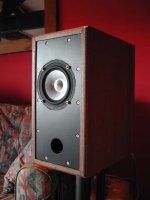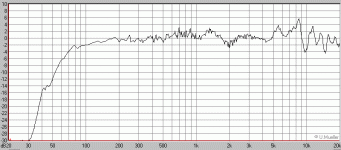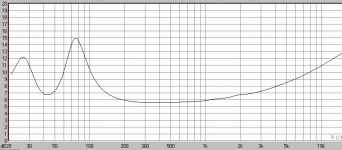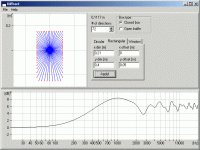I thought I'd share some pics of my latest project, a pair of Jordan JX92S-based monitors.
Vital statistics as follows:
Dimensions: 40h x 21w x 31d approx (cms)
Internal volume: 15l
Mass: 10kg each
Cost: £200/pair approx
Freq response & more details to follow...
Cheers
IH
Vital statistics as follows:
Dimensions: 40h x 21w x 31d approx (cms)
Internal volume: 15l
Mass: 10kg each
Cost: £200/pair approx
Freq response & more details to follow...
Cheers
IH
Attachments
IanHarvey said:Here's the frequency response of the unit shown, measured on-axis 10cm from the centre of the driver cone, using a Behringer ECM8000 mic.
Hmm... Are you aware of baffle step? Unless I miss something you will have to add about this to your close-field measurement to get the far-field response.
Attachments
Svante said:
Hmm... Are you aware of baffle step?
Yes, I did some simulations when positioning the driver. It has both an x and y offset from the centre point; that plus rounding-off the baffle edge made it less wiggly overall than the plot you posted.
I'm undecided whether to (a) leave the speakers alone and fiddle with the room & positioning, (b) add a passive compensation network to the speaker or (c) put compensation between source and power amp. I'm also not sure how I'm going to measure the result, as my experiences to date suggest in-room response is so messy a little 6dB step is lost in the noise.
There's always (d), listen with speakers positioned 10cm from head...
Cheers
IH
IanHarvey said:
Yes, I did some simulations when positioning the driver. It has both an x and y offset from the centre point; that plus rounding-off the baffle edge made it less wiggly overall than the plot you posted.
Ahh, nice, I just guesstimated a y offset from your picture, but as you say, it is likely that an x offset would dewhiggle the response a bit more. BTW, What *are* the measures?
IanHarvey said:
I'm undecided whether to (a) leave the speakers alone and fiddle with the room & positioning, (b) add a passive compensation network to the speaker or (c) put compensation between source and power amp. I'm also not sure how I'm going to measure the result, as my experiences to date suggest in-room response is so messy a little 6dB step is lost in the noise.
There's always (d), listen with speakers positioned 10cm from head...
Cheers
IH
I think most people nowadays use a truncated impulse response to measure far-ish field. How did you go about to get your curves?
PS (d) is nice. You won't have to bother about room acoustics, then...
IanHarvey said:
a little 6dB step is lost in the noise.
Cheers
IH
A 6dB step, applied over a band makes a rather large difference,
and will allow postioning away from walls for good soundstaging
and optimum use of room gain in the bass.
I'd add it between pre and power amplifier, easily adjustable.
Its also possible to add by modifying the PA feedback loop for
6dB more gain at LF.
Svante said:
Hmm... Are you aware of baffle step? Unless I miss something you will have to add about this to your close-field measurement to get the far-field response.
What program are you using? Looks very interessting
Svante said:
Ahh, nice, I just guesstimated a y offset from your picture, but as you say, it is likely that an x offset would dewhiggle the response a bit more. BTW, What *are* the measures?
I don't have them to hand at the minute; the X offset is about 1.5cm if memory serves. I'll post some construction details when I'm back at home.
I think most people nowadays use a truncated impulse response to measure far-ish field. How did you go about to get your curves?
I'm using AudioTester (http://www.audiotester.de/), using its frequency-sweep mode. It does have a waterfall-plot mode (which I've not really played with) - is this what you mean?
I didn't want to simply simulate the baffle diffraction results and then design its inverse as compensation; in the room where they will eventually live the baffles will be effectively flush with various bits of furniture. I'd like to actually measure the speaker+room together before fiddling with the frequency response.
Cheers
IH
Taco said:
What program are you using? Looks very interessting.
Home brewed: http://www.tolvan.com/diffract.exe
IanHarvey said:
I'm using AudioTester (http://www.audiotester.de/), using its frequency-sweep mode. It does have a waterfall-plot mode (which I've not really played with) - is this what you mean?
No, I don't think so. The method goes something like this:
Play a sound that contains all frequencies (chirp, noise or similar). Record a *long* piece of this signal, longer than the reverberation time of the room. The difference between the send and received signals gives you a frequency response (including phase) that can be transformed into an impulse response by an inverse fourier transform. This impulse response is truncated at a time before the first reflection from the room. Now fourier transform this truncated impulse response, and you will have something that looks like free field.
The limitation is the time it takes to the first reflection from the room, this will put a lower limit on the frequency range, typically it works from ~500 hertz and upwards.
Svante said:
No, I don't think so. The method goes something like this:
Play a sound that contains all frequencies (chirp, noise or similar). Record a *long* piece of this signal, longer than the reverberation time of the room. The difference between the send and received signals gives you a frequency response (including phase) that can be transformed into an impulse response by an inverse fourier transform. This impulse response is truncated at a time before the first reflection from the room. Now fourier transform this truncated impulse response, and you will have something that looks like free field.
I understand the waterfall plot thingy plays an impulse through the speakers, and slices the resultant response into chunks of a few ms each. The FFT of each chunk is displayed in a series of 2D slices forming a 3D picture. The very first slice should be the frequency response of the direct sound, and later ones give the room response.
That's how I'd like it to work anyway, but I've not done enough experiments to check whether this is actually the case.
The limitation is the time it takes to the first reflection from the room, this will put a lower limit on the frequency range, typically it works from ~500 hertz and upwards.
Damn! The balance between < 500Hz and > 500Hz is precisely what we're trying to set with the baffle-step correction.
Cheers
IH
IanHarvey said:
I understand the waterfall plot thingy plays an impulse through the speakers, and slices the resultant response into chunks of a few ms each. The FFT of each chunk is displayed in a series of 2D slices forming a 3D picture. The very first slice should be the frequency response of the direct sound, and later ones give the room response.
I might be wrong here, but i had the impression that the waterfall graph represents consecutive FFTs of a stationary (noise) signal that is shut off. The decay of resonances can then be seen in consecutive FFTs. But maybe I am wrong about this. What kind of sound is used for the waterfall graph? Noise? An impulse?
IanHarvey said:
Damn! The balance between < 500Hz and > 500Hz is precisely what we're trying to set with the baffle-step correction.
Cheers
IH
As I said this frequency is set by the time between the direct sound and the reflected sound. Assuming a spkr-mic distance of 1 m and a spkr-to-floor distance of 1.25 m, the distance difference would be 2*sqrt(1.25^2+0.5^2)-1=1.7 m. This in turn corresponds to a delay of 5 ms. So the maximum FFT length that can be used is 5 ms, which would correspond to a 200Hz resolution. Hmm... Not too bad after all, appears as if I was on the pessimistic side.
You could also take the speaker outdoors.
Svante said:
What kind of sound is used for the waterfall graph? Noise? An impulse?
It sounds like a click. It might well be an MLS sequence, but I don't know what one of them is...
You could also take the speaker outdoors.
That was Plan B, which will have to wait until it's (a) lighter and (b) warmer in the evenings.
Cheers
IH
IanHarvey said:
It sounds like a click. It might well be an MLS sequence, but I don't know what one of them is...
Aha, so if it is a click (=impulse), you are right. What you will se on the input would be the impulse response, and it the windows size of the fft is 5ms -ish the first frame should correspond to the gated response. Check it up though before relying on it!
mulebarn said:The speakers look nice----real good job!
Thanks!
I'm still in the middle of listening tests and some final tweaking, but it sounds at least as good as it looks. To give an example, I put on a bit of Bach - one of my regular test tracks, which I must have heard a hundred times on a couple of dozen systems - and was amazed to suddenly hear someone turning over the pages of music! Definitely some detail I hadn't heard before; the stereo image is wonderfully precise - a notch up from my Monitor Audio Gold 10's, even.
At present, the bass is a little light. It's clean and detailed, great for jazz/acoustic stuff, but it doesn't really rock yet. I might fiddle with the ports some more (although I'm not a fan of bass-reflex 'boom'), or the baffle-step correction described earlier would of course boost the bass and low-mids.
Cheers
IH
- Status
- This old topic is closed. If you want to reopen this topic, contact a moderator using the "Report Post" button.
- Home
- Loudspeakers
- Full Range
- Jordan monitors - pics and specs



